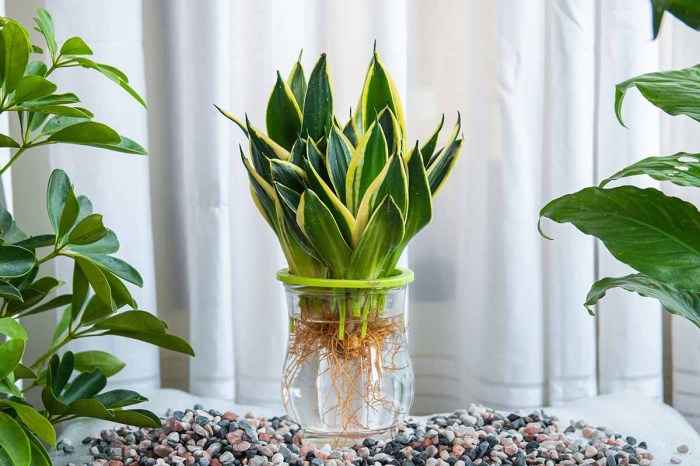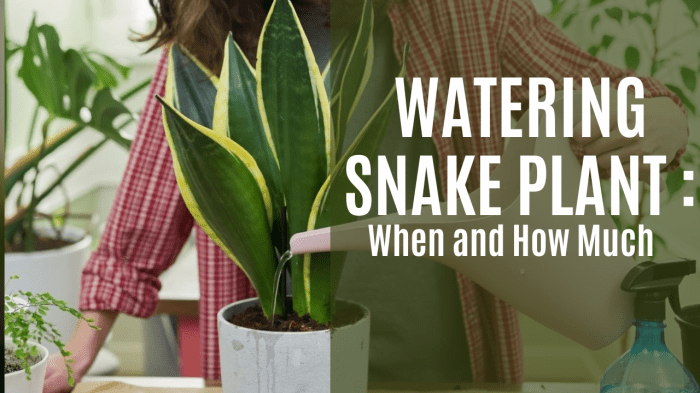How to Water a Snake Plant
Understanding Snake Plant Watering Needs
How to water a snake plant – Proper watering is crucial for the health and longevity of your snake plant. Understanding the factors that influence watering frequency will help you avoid both underwatering and overwatering, two common problems that can severely impact your plant’s growth and appearance.
Factors Influencing Watering Frequency

Source: gardenerspath.com
Proper snake plant watering involves allowing the soil to dry out completely between waterings. This contrasts with the misconception that, because plants absorb water, they’re always actively moving water internally, as explored in this article on whether can water plants move. Understanding this distinction is key to preventing root rot, a common problem in overwatered snake plants.
Therefore, infrequent but thorough watering is best.
Several factors determine how often you need to water your snake plant. These include the size of the pot, the season, and the environment where the plant is located. Larger pots retain moisture longer than smaller pots, requiring less frequent watering. During the warmer months (spring and summer), snake plants actively grow and require more frequent watering compared to the cooler months (autumn and winter) when their growth slows down.
Finally, environmental factors such as humidity and temperature also play a significant role. A dry, warm environment will necessitate more frequent watering than a humid, cool one.
Signs of Underwatered and Overwatered Snake Plants
Recognizing the signs of underwatering and overwatering is essential for maintaining a healthy snake plant. Underwatered snake plants will exhibit wilting leaves, which may become brittle and curl inwards. The soil will be completely dry to the touch. Conversely, overwatered snake plants show signs of yellowing or browning leaves, often starting from the bottom. The soil will remain soggy, and you may notice a foul odor emanating from the pot, indicating potential root rot.
Watering Needs for Different Snake Plant Varieties

Source: abanahomes.com
While the general principles of snake plant watering apply to most varieties, slight variations exist. For example, some varieties with thicker leaves may tolerate slightly drier conditions compared to those with thinner leaves. However, these differences are often subtle, and the basic principles of the “soak and dry” method remain applicable across most snake plant varieties.
Watering Schedule Based on Pot Size, Season, and Environment
| Pot Size | Season | Environment (Humidity) | Watering Frequency (approx.) |
|---|---|---|---|
| Small (under 6 inches) | Spring/Summer | Low | Every 1-2 weeks |
| Small (under 6 inches) | Spring/Summer | High | Every 2-3 weeks |
| Medium (6-12 inches) | Spring/Summer | Low | Every 2-3 weeks |
| Medium (6-12 inches) | Spring/Summer | High | Every 3-4 weeks |
| Large (over 12 inches) | Spring/Summer | Low | Every 3-4 weeks |
| Large (over 12 inches) | Spring/Summer | High | Every 4-6 weeks |
| All Sizes | Autumn/Winter | All | Every 4-6 weeks or even less frequently |
Note: These are approximate guidelines. Always check the soil moisture before watering.
Watering Techniques
The proper watering technique is as important as the frequency. Using the right method ensures the snake plant receives adequate hydration without risking overwatering.
The “Soak and Dry” Method
The “soak and dry” method is the most effective way to water snake plants. This involves thoroughly soaking the soil until water drains from the drainage holes, then allowing the soil to dry out completely before watering again. This prevents the soil from becoming waterlogged, which can lead to root rot.
Importance of Well-Draining Potting Mix
Using a well-draining potting mix is crucial for preventing overwatering. A mix that retains too much moisture will create an environment conducive to root rot. A good potting mix for snake plants typically includes a combination of potting soil, perlite, and coarse sand to improve drainage and aeration.
Proper Watering Technique
When watering, pour water slowly and evenly around the base of the plant, avoiding getting water on the leaves. Waterlogged leaves are susceptible to fungal diseases. Allow excess water to drain completely from the drainage holes. Do not let the plant sit in standing water.
Checking Soil Moisture
Several methods can be used to check soil moisture. The finger test involves inserting your finger about an inch into the soil. If the soil feels dry, it’s time to water. Alternatively, a moisture meter can provide a more precise reading of soil moisture levels.
Addressing Watering Issues
Even with careful attention, watering problems can occur. Knowing how to address these issues is crucial for keeping your snake plant healthy.
Common Watering Mistakes
Common mistakes include overwatering, underwatering, and using improperly draining soil. Overwatering is often the most damaging, leading to root rot and plant death. Underwatered plants will show signs of wilting and stress. Using the wrong potting mix can exacerbate both overwatering and underwatering issues.
Reviving an Underwatered Snake Plant
To revive an underwatered snake plant, thoroughly water the plant using the “soak and dry” method. Monitor the plant closely and water again when the soil is completely dry. With proper care, the plant should recover within a few weeks.
Addressing Root Rot, How to water a snake plant

Source: happyhousegarden.com
If your snake plant shows signs of root rot (soggy soil, foul odor, yellowing leaves), you need to act quickly. Remove the plant from its pot and carefully inspect the roots. Trim away any mushy or blackened roots using clean, sharp scissors. Repot the plant in fresh, well-draining potting mix, ensuring the pot has adequate drainage holes. Reduce watering frequency to prevent further rot.
Adjusting Watering Frequency Based on Environmental Changes
If you move your snake plant to a different location or experience significant changes in temperature or humidity, you may need to adjust your watering frequency. For instance, a move to a drier environment might require more frequent watering, while a cooler environment might necessitate less frequent watering.
Long-Term Care and Maintenance: How To Water A Snake Plant
Establishing a consistent watering routine and following best practices will ensure the long-term health of your snake plant.
Comprehensive Yearly Watering Schedule
A general guideline for a yearly watering schedule is to water more frequently during spring and summer (every 1-4 weeks, depending on pot size, environment, and soil moisture), and less frequently during autumn and winter (every 4-6 weeks or even less). Always check the soil moisture before watering.
Best Practices for Maintaining a Healthy Snake Plant
- Use a well-draining potting mix.
- Water thoroughly but infrequently, allowing the soil to dry out completely between waterings.
- Avoid getting water on the leaves.
- Check soil moisture regularly using the finger test or a moisture meter.
- Adjust watering frequency based on seasonal changes and environmental conditions.
Suitable Containers
Terracotta pots are generally preferred for snake plants as they allow for better air circulation and drainage, reducing the risk of overwatering. Plastic pots can also be used, but ensure they have adequate drainage holes. The pot size should be appropriate for the plant’s size, avoiding pots that are too large or too small.
Ideal Watering Process (Visual Description)
Imagine gently pouring lukewarm water around the base of the snake plant, ensuring the water reaches the entire root system. The water should soak into the soil until it drains out of the drainage holes. Allow the excess water to drain completely, preventing the plant from sitting in standing water. Observe the soil moisture regularly to determine the next watering time.
Specific Scenarios and Considerations
Different growing conditions and water types can influence how you water your snake plant. Understanding these nuances will help you optimize watering practices for optimal plant health.
Indoor vs. Outdoor Watering
Snake plants grown indoors generally require less frequent watering than those grown outdoors, due to lower evaporation rates. Outdoor plants, especially in sunny, dry climates, will require more frequent watering to compensate for increased evaporation.
Impact of Different Water Types
While snake plants are generally tolerant of tap water, using filtered water or rainwater is preferable as it reduces the risk of mineral buildup in the soil. Hard water with high mineral content can interfere with nutrient absorption and potentially damage the plant.
Role of Humidity
Higher humidity reduces the frequency of watering needed. In humid environments, the soil will retain moisture for longer periods, thus requiring less frequent watering. In contrast, lower humidity leads to quicker evaporation, requiring more frequent watering.
Watering During Different Growth Stages
During active growth (spring and summer), snake plants require more frequent watering. During dormancy (autumn and winter), watering should be reduced significantly to prevent overwatering and root rot. Always monitor the soil moisture before watering, regardless of the growth stage.
FAQ Overview
Can I use tap water for my snake plant?
Ideally, use filtered or room-temperature tap water that has been allowed to sit for 24 hours to allow chlorine to dissipate. Avoid using very hard water.
How often should I fertilize my snake plant?
Fertilize sparingly, only during the active growing season (spring and summer), using a balanced, diluted liquid fertilizer once or twice a month.
My snake plant’s leaves are yellowing. What should I do?
Yellowing leaves can indicate overwatering or underwatering. Check the soil moisture and adjust your watering accordingly. Rule out other factors like poor drainage or insufficient light.
What type of pot is best for a snake plant?
Terracotta pots are ideal as they allow for better drainage and aeration, preventing overwatering. Ensure the pot has drainage holes.




















